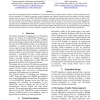Free Online Productivity Tools
i2Speak
i2Symbol
i2OCR
iTex2Img
iWeb2Print
iWeb2Shot
i2Type
iPdf2Split
iPdf2Merge
i2Bopomofo
i2Arabic
i2Style
i2Image
i2PDF
iLatex2Rtf
Sci2ools
LREC
2008
2008
Performance Evaluation of Speech Translation Systems
One of the most challenging tasks for uniformed service personnel serving in foreign countries is effective verbal communication with the local population. To remedy this problem, several companies and academic institutions have been funded to develop machine translation systems as part of the DARPA TRANSTAC (Spoken Language Communication and Translation System for Tactical Use) program. The goal of this program is to demonstrate capabilities to rapidly develop and field free-form, two-way translation systems that would enable speakers of different languages to communicate with one another in real-world tactical situations. DARPA has mandated that each TRANSTAC technology be evaluated numerous times throughout the life of the program and has tasked the National Institute of Standards and Technology (NIST) to lead this effort. This paper describes the experimental design methodology and test procedures from the most recent evaluation, conducted in July 2007, which focused on English to...
Education | Effective Verbal Communication | LREC 2008 | Real-world Tactical Situations | Translation Systems |
| Added | 29 Oct 2010 |
| Updated | 29 Oct 2010 |
| Type | Conference |
| Year | 2008 |
| Where | LREC |
| Authors | Brian A. Weiss, Craig Schlenoff, Greg Sanders, Michelle Potts Steves, Sherri L. Condon, Jon Phillips, Dan Parvaz |
Comments (0)

